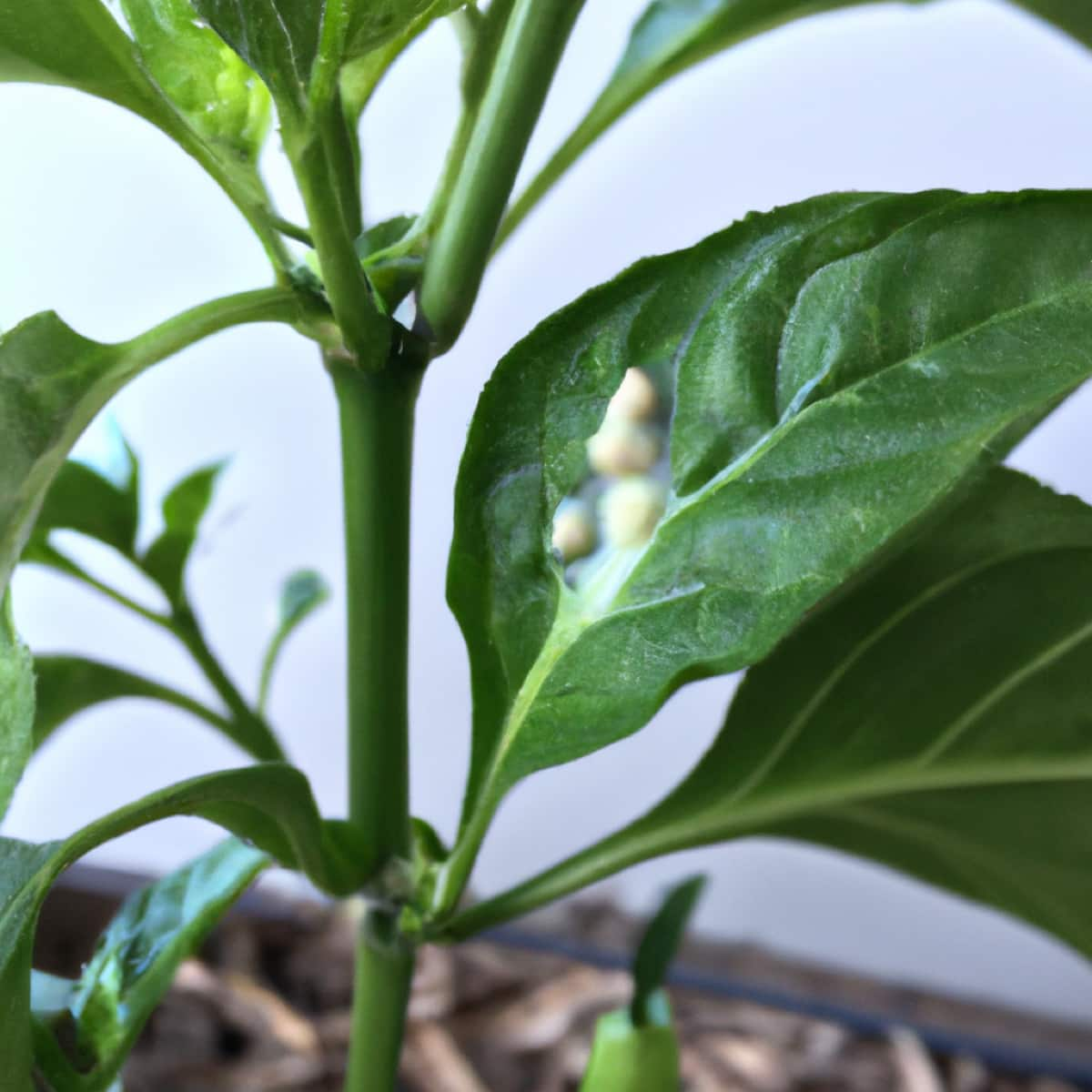The Chilli Mealybug, Ferrisia virgata, belonging to the Family Pseudococcidae of the Order Hemiptera, is a common pest that causes significant yield losses and reduces the quality of crops worldwide. This tiny insect feeds by sucking sap from the plant tissues, ultimately weakening the chilli plant and reducing its yield. The Chilli Mealybug can cause stunted growth, leaf curling, and premature leaf drop, among other symptoms, making it challenging to control and eradicate.

This pest can quickly multiply, and under favourable conditions, a single mealybug can produce up to 600 offspring. To effectively manage this pest, it is essential to understand its life cycle, its preferred habitats, and the best methods for controlling it. This article will provide an overview and discussion of the Chilli Mealybug Pest in Chilli crops, including its symptoms, identification techniques, and control.
Mealybug Pest Management in Chilli
Life Cycle of Chilli Mealybug Pest in Chilli Crop
The life cycle of the Chilli Mealybug pest has four stages. They are egg, crawler, nymph, and adult. The life cycle begins when the female chilli mealybug lays oval-shaped eggs in a cottony mass on the chilli plant’s leaves, stems, and fruits. Each egg mass can contain up to 250 eggs. After hatching, the newly emerged nymphs, also known as crawlers, start to move around the plant, searching for suitable feeding sites. The crawler stage is a free mobile and the most vulnerable stage of the Chilli Mealybug, making it an ideal target for management strategies.
The nymphal stages of the Chilli Mealybug include three moulting stages before becoming adults. During this period, the mealybugs feed and grow, causing damage to the chilli plant. The nymphs secrete a white waxy substance that protects them from predators, desiccation, and insecticides. The adult female mealybug produces a pheromone that attracts males for mating, and after mating, the female mealybug continues to lay eggs and produce offspring. The entire lifecycle of the Chilli Mealybug can be completed within three to four weeks.
Occurrence of Chilli Mealybug Pest in Chilli Crop
- Location of Chilli Mealybug Pest: This pest infests Chilli crops in India, Bangladesh, Nepal, Africa, Sri Lanka, China, Thailand, Malaysia, Vietnam, Indonesia, the United States, Mexico, Brazil, Colombia, Ecuador, the Philippines, New Zealand, and Australia.
- Host Range: The Chilli Mealybug pest infects crops like Chilli, Citrus, Eggplant, Sweet Potato, Grapes, Pomegranate, Avocado, Mango, Guava, Apple, Pear, Peach, and Apricot.
Factors Favoring the Population Increase of Chilli Mealybug Pest in Chilli Crop
- Temperature – The pest prefers warm temperatures between 25°C to 30°C. The pest can complete its lifecycle quickly, leading to a rapid increase in population density.
- High Humidity – The pest prefers high humidity levels, and relative humidity of 80-90% is optimal for its survival, reproduction, and development of a waxy coating that shields them from predators and insecticides.
- Plant Damage – Any damage due to injuries creates wounds that attract the pest due to exposure to the plant’s sugary sap.
- Plant Nutrition – A lack of essential nutrients can weaken the plant’s natural defences, making it more vulnerable to pest attack.
- Weed Management – Weeds in and around the chilli field can harbour the pest, providing a constant source of infestation to the chilli crops.
Identification of Chilli Mealybug Pest in Chilli Crop
- Egg: The eggs are small, white, oval-shaped, and about 0.4mm long.
- Nymph: The nymphs are small, oval-shaped, yellow to light pink, and about 1.5 to 2mm long. They have a segmented body covered with a white, powdery wax that gives them a cottony appearance.
- Adult: The adult female is wingless, oval-shaped, about 3-5mm long, and covered with a white waxy coating. The male is smaller, darker, and has wings.
Damage Symptoms of Chilli Mealybug Pest in Chilli Crop
- The mealybugs suck the sap from the phloem tissues of the plant and excrete honeydew-like sugary substance, which encourages the growth of sooty mould.
- This honeydew attracts other insect pests like ants which can cause further damage.
- The mealybugs are located on the underside of the leaves and twigs in clusters resembling a cottony appearance.
- The pest infestation can cause yellowing and curling of younger leaves, stunted growth, and premature fruit drop.
In case you missed it: Chilli Thrips Management: Symptoms, Treatment, Chemical, Biological, and Organic Control

Percentage of Yield Loss in Chillis Due to Chilli Mealybug Pest
- In India, the yield losses due to Chilli Mealybug pests are 10-70%. In Bangladesh, the losses are 50%. In Nepal, the losses are 50%. In Thailand, the yield loss is 10-50%. In Malaysia, it is 10-50%. In Vietnam, the losses are 20-50%. In Sri Lanka, the losses are 50%. In Indonesia, the losses are 60%. In Africa, it is 20-80%. In the United States, it is 10-30%. In Mexico, it is 10-50%. In Brazil, it is 10-50%. In China, it is 10-50%.
- In Colombia, the losses are 10-50%. In Ecuador, it is 10-40%. In New Zealand, it is 5-10%. In Australia, it is 50%. In the Philippines, the yield losses are 10-50%. The Economic Threshold Level (ETL) for the Chilli Mealybug pest is set at 2 to 5 Mealybugs per leaf.
Cultural Control of Chilli Mealybug Pest in Chilli Crop
- Crop Rotation – Planting non-host crops, such as legumes or cereals, in rotation with chilli crops can help reduce the pest population.
- Pruning and Harvesting – Pruning can help remove infested plant parts, and harvesting can help remove the pest from the field before they can cause further damage.
- Sanitation – These pests can hide in plant debris, weeds, and other plant material, and their removal can help reduce pest populations.
- Soil Management – Proper soil management practices, including regular irrigation, drainage, and fertilization, can help improve plant health and reduce the incidence of pests.
- Irrigation – Over-watering can increase humidity, while under-watering can weaken plants and make them more susceptible.
Biological Control of Chilli Mealybug Pest in Chilli Crop
- Ladybird beetles – Cryptolaemus montrouzieri can feed on the pest’s eggs, reducing the pest population.
- Lacewings – Chrysoperla carnea can also feed on the pest’s eggs, reducing the pest population.
- Parasitoids – Anagyrus lopezi can lay their eggs in the pest, killing it in the process.
- Entomopathogenic Fungi – Beauveria bassiana and Metarhizium anisopliae, can infect and kill the pest, reducing the population.
- Beneficial Bacteria – Pseudomonas fluorescens can produce toxins that kill the pest, reducing the population.
Chemical Control of Chilli Mealybug Pest in Chilli Crop
- Spray insecticides like, Dimethoate, Thiamethoxam, Chlorpyriphos, Malathion, Cypermethrin, Deltamethrin, Phosphomidon, and Imidacloprid on the foliage to control the pest.
- Apply Pyrethrins on the affected area to minimize the impact.
Organic Control of Chilli Mealybug Pest in Chilli Crop
- Spray botanical insecticides like neem oil, pyrethrin, and rotenone.
- Apply Vermicompost, Manure, and FYM to control the pest.
- Plant extracts from neem, garlic, tobacco, cinnamon, ginger, turmeric, hot pepper, and Chilli can be applied to manage the infestation.
Preventive Measures for Control of Chilli Mealybug Pest in Chilli Crop
- Avoid Over-Fertilization – Over-fertilization can produce soft, succulent plant tissues that are more susceptible to pest infestations.
- Proper Irrigation – Proper irrigation can help prevent water stress, weakening plants and making them more susceptible to pest infestations.
- Sticky Traps – Use yellow sticky traps with grease and sticky oils to control the pest.
- Pheromone Traps – Pheromone traps can help monitor the pest population and determine the timing of insecticide applications.
- Alternate Hosts – Remove alternative hosts, such as brinjals and sweet potatoes.
- Physical Barriers – Covering chilli plants with physical barriers such as insect-proof nets can prevent the pest from accessing the crop.
- Monitoring – Monitor the crops regularly to identify pest infestation in the early stages to keep it under control.
In case you missed it: Chilli Aphid Pest Management: Symptoms, Treatment, Chemical, Biological, and Organic Control

Conclusion
The Chilli Mealybug Pest, Ferrisia virgata, is a major pest that affects Chilli production worldwide, causing significant yield losses and economic damage. Implementing IPM strategies can help reduce the likelihood of pest infestations, minimize yield losses, and promote sustainable chilli crop production. With proper management practices, chilli crop producers can reduce the impact of the pest and maintain a healthy and productive crop.
- Deworming Schedule for Dogs/Puppies: A Beginners Guide
- How to Prevent and Control Parasites in Goats
- Beneficial Insects in Pest Management
- Natural Solutions for Pest Control in Flower Gardens
- Types of Fungicides Used in Agriculture
- Common Issues in the Fruit Development Stage of Pomegranate Farming
- Fruit Development Issues in Papaya: Easy Solutions and Treatment
- Soil-Borne Diseases and How to Protect Your Plants
- Practices to Prevent Disease Spread in the Garden